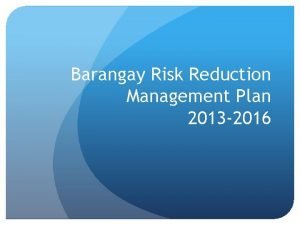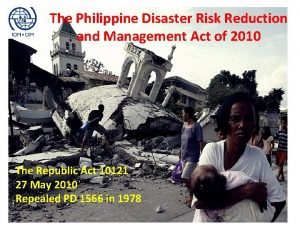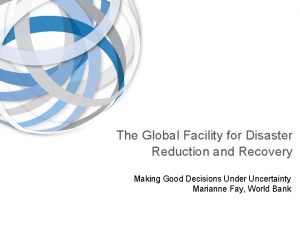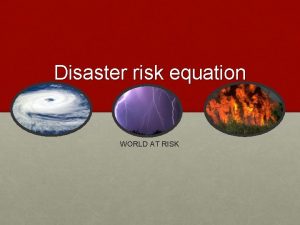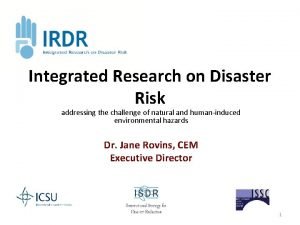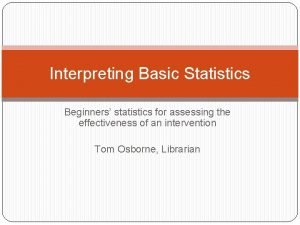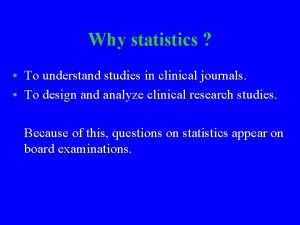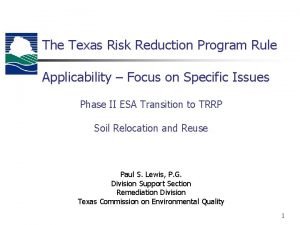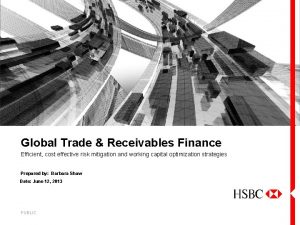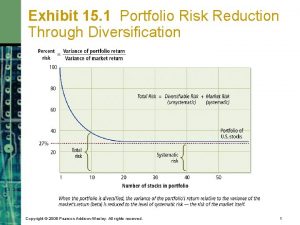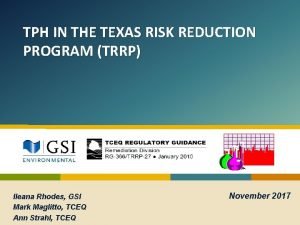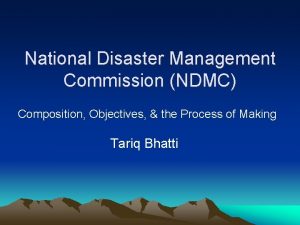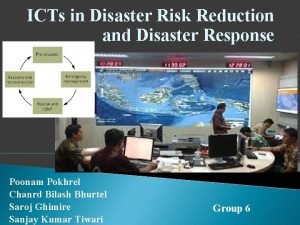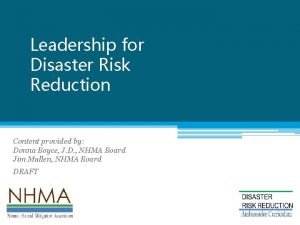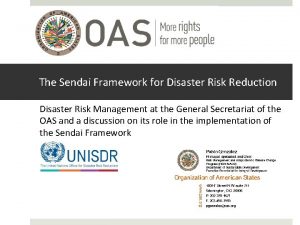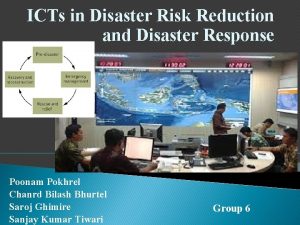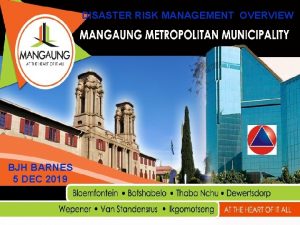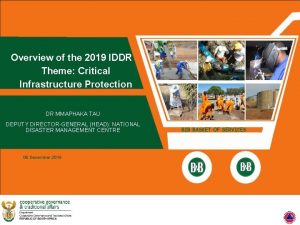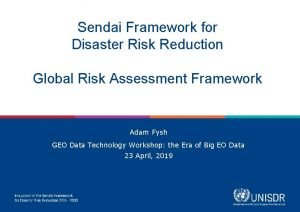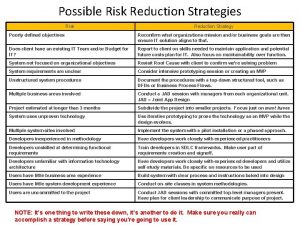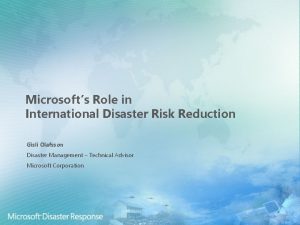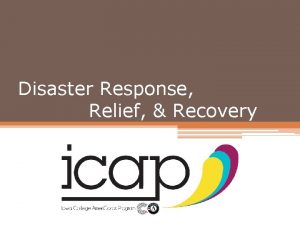NDMC International Day for Disaster Risk Reduction IDDR































- Slides: 31

NDMC International Day for Disaster Risk Reduction (IDDR) Substantially reduce disaster damage to critical infrastructure and disruption of basic services, including through developing their resilience Practitioners Working Session Date: 5 December 2019

Eskom Disaster Planning 2

Discussion points for developing resilient critical infrastructure… Policy - Disaster Management & Critical Infrastructure Incident Response Plans Lessons, challenges and opportunities from hazards Tools and resources required for response 4

Eskom Disaster Management Eskom is required to comply with the requirements of the Disaster Management Act (Act No. 57 of 2002), as amended, National Disaster Management Framework (NDMF) and the South African Grid Code with regards to system operations and preparedness for electricity related incidents. The Eskom Disaster Management Plan is built on the Board approved Eskom Risk and Resilience policy framework. The Eskom Disaster Management Plan addresses the initiatives under the Enterprise Resilience Programme that will drive Eskom’s compliance to a Level 3 Disaster Management Plan. 5

Eskom Enterprise Risk and Resilience Policy (Board Approved) Policy Framework Eskom Policy Framework and Standards Eskom Integrated Risk & Resilience Framework Eskom Holdings Risk & Resilience Plan Standards Eskom Integrated Risk Management Standard Eskom Business Continuity Management Standard Eskom Disaster Management Standard Eskom Incident Command Standard Eskom Planning and Execution of Simulated Exercises Standard

Concept: Disaster means a progressive or sudden, widespread or localised, natural or human-caused occurrence whicha) causes or threatens to cause- • death, injury or disease; • damage to property, infrastructure or the environment; or • significant disruption of the life of a community; and b) is of a magnitude that exceeds the ability of those affected by the disaster to cope with its effects using only their own resources; Disaster Management Act (Act No 57 of 2002), as amended 7

Concept: Disaster Management means a continuous and integrated multi-sectorial, multi-disciplinary process of planning and implementation of measures aimed at: • preventing or reducing the risk of disasters; • mitigating the severity or consequences of disasters; • emergency preparedness; • a rapid and effective response to disasters; and • post-disaster recovery and rehabilitation. Disaster Management Act (Act No 57 of 2002), as amended 8

Disaster Management Concept in Eskom the cause of a disaster National Provincial Local Eskom impacted by external disaster threats Eskom a response partner in an external event Addresses scenarios whereby Eskom’s capability to prevent, mitigate, respond and recover is exceeded

Concepts and principles in Eskom

Eskom’s roles in disaster management

Eskom’s priority disaster scenarios Priority National Disaster Risks (Determined at Eskom Corporate Level) 1 • • Nuclear incident National blackout Severe supply/demand constraint Financial/Economic Collapse 2 • • National industrial action (Eskom/SA) Cyber incidents/Major IT Systems Failure Drought and Water Related Disasters Solar/geomagnetic storm Terrorism / Political instability Pandemic National liquid fuel crisis Environmental and Climate Change Disasters Provincial Disaster Risks (Determined at a provincial level) • • • Major regional system constraint Snow/ice storms Floods Regional blackout Social unrest Tropical cyclone/Anticyclone Air/water pollution/contamination Veld/forest fires Water control structure/dam/levee failure Earthquake Tsunami/storm surge National disaster priorities are addressed by national working groups (Executive allocated) Provincial disaster priorities are addressed by Provincial Resilience Teams Local disaster priorities are addressed by the site management team

Eskom Disaster Management Planning Framework Disaster Planning Guideline Eskom Disaster Management Plan Institutional Arrangements Disaster Priorities Context Risk Assessment Objectives Accountable GE Working Group Readiness Assessment Toolkit Disaster Plan X Incident Command (RACI) Stakeholder Plan Standard Operating Procedures Preparedness Response SOP’s Recovery SOP’s Assessment Treatment Plan Country Plan SOP’s Reporting Dashboard • Divisions (TCC’s) • Sites • 3 rd Party Contracts • ERCC/PJCC’s The provinces will coordinate their plans based on the national and divisional plans

Eskom’s Integrated Emergency Response Structures Eskom Emergency Response Command Centre (ERCC) Objective: Manage Eskom’s co-ordinated response Integrated with: NDMC, Nat. JOC, National Government Objective: Manage internal and external crisis communication Integrated with: GCIS, Provincial Comm’s (PJCCs) Eskom Crisis Communications Divisions Tactical Command Centres (TCC) Objective: Manage divisional BCM & disaster priorities Integrated with: ERCC, Sector departments Sites Emergency Preparedness Centers Objective: Manage site-level BCM & disaster priorities Integrated with: Site NKP JOC’s, PJCCs, TCCs, Provincial Joint Command Centres (PJCC) Provincial Emergency Operating Center (PEo. C) Koeberg Emergency Command Centre Response: Objective: Manage Eskom’s integrated provincial response Integrated with: PDMCs, Prov. JOCs, Provincial Government Objective: Coordinate & support provincial response priorities Integrated with: PJCC, Local Emergency Services, JOCs, DTCC Objective: Manage Koeberg nuclear safety and response Integrated with: ERCC, Co. CT Disaster Management, PJCC Strategic Tactical Operational/functional

Disaster Management – Provincial Engagement Framework Country Plans – National Disaster Risks Accountable Eskom Executive Sponsor Eskom National Plans Senior Manager Enterprise Resilience Chief Director Disaster Risk, Capacity Building, Interventions NDMC Eskom Enterprise Resilience PRT Provincial coordinator PDMC Head Provincial Departments / Sectors Metro’s Municipal authorities Provincial stakeholders (large industry etc) National WG Lead Chief Advisor – Disaster Management / Middle Manager – Risk (PRT support) Provincial Resilience Team General Manager Provincial executive Eskom divisions Municipal electricity dept. 's Communications Provincial Plans – National & Provincial Disaster Risks Eskom Provincial Plans PDMC Head Responsible Manager / Provincial WG Lead

Eskom Incident Response Plans T 1 T 2 Potential Impact Incident T 3 Early Warnings / Triggers Analyze impact on operations Notification, Activation & Escalation Classification: Alert/ Emergency/Disaster 16 Contingency Plan Preparedness / Response / Recovery

Major Electricity Related Incident Readiness Heavy reliance on emergency reserves may not be sustainable. Eskom stages 5 -8. g i n, g si De Grid code compliance (10 stock piles below minimum ) Plant performance m om c i ss t in in on n e nc a en a M n po se O io at r pe ns u an M al o sp re ic at t Au se ng s re om Blackout ic at m to u A i nd la is n io t ck a Bl ar st at or t s Re Failed restoration Curtailment Operating reserves (2000 MW) Demand response Auto start (10 -20% 2 hr) Load shedding schedules 1 -4 15 -30 min Contingency schedules 5 -8 Real time response 7 Stages (50%) 49. 247 Htz 3 x 3. 3% 4 x 10% Islanding units Black start facilities Power System Restoration Plan

Evolution of Eskom planning & response structures es r u tr s e s on d e t a sp e r r g e t c n e i in 2008 tea s d n il r teg in 2006 d e t a e s re u t c u r t ms t uc simulation exercises o c ti c a t 2015 c al a m m PRT s PJCC s TCC s s d an m m o tc n e id c in 2016 country integration ICS ERCC m te s y

Eskom’s Integrated Emergency Response Structures Eskom Emergency Response Command Centre (ERCC) Objective: Manage Eskom’s co-ordinated response Integrated with: NDMC, Nat. JOC, National Government Objective: Manage internal and external crisis communication Integrated with: GCIS, Provincial Comm’s (PJCCs) Eskom Crisis Communications Divisions Tactical Command Centres (TCC) Objective: Manage divisional BCM & disaster priorities Integrated with: ERCC, Sector departments Sites Emergency Preparedness Centers Objective: Manage site-level BCM & disaster priorities Integrated with: Site NKP JOC’s, PJCCs, TCCs, Provincial Joint Command Centres (PJCC) Provincial Emergency Operating Center (PEo. C) Koeberg Emergency Command Centre Response: Objective: Manage Eskom’s integrated provincial response Integrated with: PDMCs, Prov. JOCs, Provincial Government Objective: Coordinate & support provincial response priorities Integrated with: PJCC, Local Emergency Services, JOCs, DTCC Objective: Manage Koeberg nuclear safety and response Integrated with: ERCC, Co. CT Disaster Management, PJCC Strategic Tactical Operational/functional

Integrated emergency response structures National Provincial Strategic Eskom Emergency Response Command Centre (ERCC) Provincial Joint Command Centers (PJCCs) x 9 Tactical Divisional Tactical Command Centres (TCCs) Provincial Emergency Operations Centres (PEOCs) Operational Ref: Eskom Incident Command Standard Rev 1. 0 Site National Key Point Joint Operating Committees Site Emergency Operations Centres; Proto teams. (Operations*)

Incident Response Plans – Emergency Response Structure ERCC (National) PJCC (Provincial) TCC (Divisional) Nuclear Safety Security Safety Operations Section Logistics Section Liaison Planning Section 21 Public Information Finance

Standardised incident command (ERCC) Eskom Incident Commander Chairman of the ERCC The GCE is the client of the Eskom ICS response Unified Command Staff Operations Section Unified Command: ERCC Eskom Role: Integrates all relevant divisional priorities and provides strategic direction for the disaster, Spokesperson based on the client’s (GCE’s) requirements. Safety: GE R&S (TCC) Role: Safety of personnel in individual actions and network security. Logistics Section Liaison: GM Stakeholder Role: Engagement with response partners and key stakeholders Planning Section Public information: GM Crisis Communications Role: Crisis comm’s, media engagement and tracking Finance/Admin Section Head: Appointed by IC Support: TCC Chairs Head: Head of ER Support: Plan WG Chair Head: Chair Finance TCC Support: Business partners Role: Develop tactics to be used in line with the strategies allowed to achieve the objectives given Role: Ensure the operations plan is adequately resourced in order to meet the given objectives Role: Consolidates information for the next planning period Produces the Eskom Incident Action Plan Role: Manages, provides and conserves the money

ICS incident objectives Principle: Manage by objectives • Objectives are communicated throughout the entire ICS organisation through the incident planning process. • The Incident Management Team aims to change an “unacceptable abnormal” into an “acceptable abnormal”. • Objectives are set per incident and per operational period. • An Incident Objective is one of the goals of the end state of the incident that will allow the IMT to close the incident • Operational period objectives are realistic goals for a single operational period that work towards the incident objectives Incident objectives are established based on the following priorities: Life saving Incident stabilization Property / asset preservation

Lessons, challenges and opportunities from hazards Local Major Electricity Related Incidents: • Beatrix Incident • Majuba Coal Silo Collapse International Electricity Related Incidents: • UK Blackout • Venezuela Blackout These incidents were used as case studies for disaster risk reduction, improvement in contingency planning, updating training and awareness programmes

Eskom Beatrix Incident (Free State OU) – 31 January 2018 25 • • 31 January 2018 – 23 h 18 Beatrix 132 k. V line in Welkom collapsed due to severe weather conditions leading to 940 miners being trapped underground. There are 3 independent lines feeding the mines but due to this Theseus Beatrix line collapsing onto Theseus Oryx line which led to a total loss of supply. Instead of opting for wooden pole structures being installed, steel monopole structures were preferred for DRR, resulting in delays; power was restored at 1: 40 on 2 February 2018. There were several other outages due to the storm on the Distribution and Transmission lines. Eskom PJCC coordinated the restoration efforts, prioritizing mining area and providing technical resources to Beatrix mine including generator and diesel as the mine’s generator could not deliver the required power to hoist up the miners as well as support pumping out of water and ventilation. PJCC notified the PDMC, Prov. Joint and Office of the Premier. Support was requested from SANDF for generators to be dispatched to the mine to assist with the evacuation. In the interim, the power system outages were being addressed by the response teams.

Majuba Silo Collapse – 1 November 2014 26 • • Operating staff reported a visible crack on Silo 20; all personnel working in the area were evacuated. Shortly thereafter, Silo 20 which is the central coal storage silo with a capacity of 10, 000 T collapsed. Immediate station production output reduced from 3600 MW to 1800 MW, leading to the stage 2 load shedding on 2 November 2014 to ensure build-up of reserves for the upcoming week. Eskom ERCC and PJCC were activated to respond to this incident. First priority was to protect the power grid and assess impact on power supply to the country. Mobile coal feeders had to be sourced from other power stations to enable a manual feed of coal to the units via the incline conveyors ensuring the power station was able to operate at least at a minimum of half-load. To supplement the operations, Eskom needed 15 to 16 trucks an hour and four per minute to feed coal into the operating silos. Over the next few days, power production increased steadily at 1400 MW with 5 of 6 units operating By the 7 th November the national power grid had stabilised and did not implement load shedding

Majuba Silo Collapse – Recovery Project 27 original timeline The Permanent Solution scope for the recovery project included rebuilding of Coal Silo 20, the reinforcement of Coal Silos 10 and 30, a new lift shaft, two new piers and the reinstatement of the coal conveyor system, i. e. the Over silo – and the Overland Conveyors, including its associated auxiliary and ancillary equipment. Construction work was completed by the end of December 2016. Ahead of schedule!

UK Blackout – 9 August 2019 • An hour-long outage/blackout cut off one million electricity customers, including homes, businesses, one hospital and Newcastle Airport and caused disruption on the rail network was due to a lightning strike. • The power cuts were the result of an unusual issue that led to the almost simultaneous loss of output from two generators • There were lightning strikes that hit the electricity grid that day that struck a transmission line which returned to normal operation after about 20 seconds. • Around 500 MW of generation capacity was also disconnected – all of which is normal for such events. • Hornsea and Little Barford reduced supply to the grid, disconnecting 1, 378 MWs which unexpectedly tripped in response to a lightning strike - an extremely rare and unexpected event. • Back-up power and other tools were used but the frequency fell to 48. 8 Hz, which is a level at which secondary back-up systems kicked in for grid safety. • All returned to normal within an hour.

Venezuela Blackout – 7 March 2019 • • 8 March 2019 The first widespread blackout began on 7 March 2019 at 4: 56 pm, restored to majority of the country on 14 March 2019. It affected the electricity sector in Venezuela in most of its 23 states, as well as Roraima border state of Brazil, causing serious problems in hospitals and clinics, industry, transport and in water service and at least 43 deaths. On 12 March, power returned to some parts of the country, but Caracas remained only partially powered and western regions near the border with Colombia remained dark. 14 to 16 of 23 states were again without power from 25 March to 28 March; whereby at least four people died as a result of the three-day lack of power. Another blackout started in the evening of 29 March, followed by another 24 hours later. During the month of March, Venezuela was without power for at least 10 days overall. The ongoing power outages have worsened the crisis in Venezuela and "suffering, cutting off water supplies and leaving hospitals and airports in the dark". Another major national blackout occurred on 22 July. https: //en. wikipedia. org/wiki/2019_Venezuelan_blackouts

Tools and Resources Required for Response Requirements are specific to the incident - Memorandum of Agreement or Cooperation is required for the various contingency plans Support required • Water – Cooling and processing at Coal Power Plants, Pumped storage during peak periods and Hydro power plants; Facilities require water for cooling data centres and ablution facilities for employees • Liquid Fuel – OCGTs, Facilities Diesel Generators and Fleet (incl. aviation) • Communication – Mobile and LAN networks, Satellite phones / network, rugged field tablet • Coal – Coal contracts for Coal power stations; top-ups for emergency operations • P&SCM - expedited processes and exemptions under emergency procurement; National Treasury expedited processes • Diesel Generators for MWP and alternate emergency response site – linked to Liquid Fuel Eskom’s main objective is to restore power; whilst it is supported by the various key response partners and role players to provide the services required timeously, efficiently and effectively

Country-Level Planning • NDMC will be coordinating the major electricity related incident country level planning exercise in Q 4. All sector departments will be requested to prepare and participate according to their mandates. NDMC will issue more information closer to the time. • PDMCs are requested to prepare to engage Eskom with regards to major electricity related incidents planning. A provincial disaster management response structure which is inclusive of sector departments is recommended to be initiated for an integrated and coordinated response. 23 November 2020 31

In closing… 32
 Day 1 day 2 day 3 day 4
Day 1 day 2 day 3 day 4 Bdrrm plan message
Bdrrm plan message Philippine disaster risk reduction and management act
Philippine disaster risk reduction and management act National disaster risk reduction and management framework
National disaster risk reduction and management framework Ndmc pension portal
Ndmc pension portal Risk avoidance insurance
Risk avoidance insurance Credit risk market risk operational risk
Credit risk market risk operational risk Day 1 day 2 day 817
Day 1 day 2 day 817 Global facility for disaster reduction and recovery
Global facility for disaster reduction and recovery Disaster equation examples
Disaster equation examples George washington crisis management
George washington crisis management Integrated research on disaster risk
Integrated research on disaster risk International disaster database
International disaster database Disaster recovery international
Disaster recovery international Wsjf example
Wsjf example Relative risk reduction
Relative risk reduction Number need to treat
Number need to treat Risk reduction strategies for new entry exploitation
Risk reduction strategies for new entry exploitation Relative risk reduction formula
Relative risk reduction formula Trrp-2
Trrp-2 Absolute risk formula
Absolute risk formula Risk reduction strategies for new entry exploitation
Risk reduction strategies for new entry exploitation Receivables finance risk reduction
Receivables finance risk reduction Risk reduction through diversification
Risk reduction through diversification Random diversification
Random diversification Trrp
Trrp Risk reduction strategies for new entry exploitation
Risk reduction strategies for new entry exploitation Fspos
Fspos Typiska drag för en novell
Typiska drag för en novell Tack för att ni lyssnade bild
Tack för att ni lyssnade bild Vad står k.r.å.k.a.n för
Vad står k.r.å.k.a.n för Varför kallas perioden 1918-1939 för mellankrigstiden?
Varför kallas perioden 1918-1939 för mellankrigstiden?

